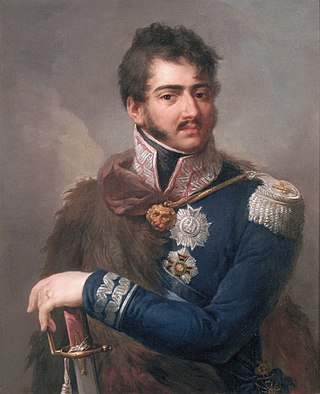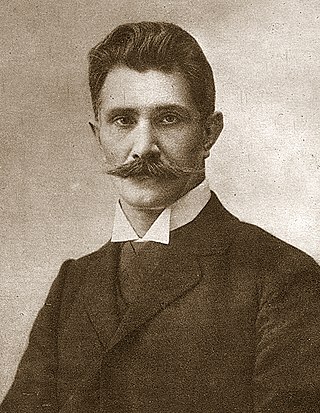
Prince Józef Antoni Poniatowski was a Polish general, minister of war and army chief, who became a Marshal of the French Empire during the Napoleonic Wars.

The Kingdom of Galicia and Lodomeria, also known as Austrian Galicia or colloquially Austrian Poland, was a constituent possession of the Habsburg monarchy in the historical region of Galicia in Eastern Europe. The crownland was established in 1772. The lands were annexed from the Polish-Lithuanian Commonwealth as part of the First Partition of Poland. In 1804 it became a crownland of the newly proclaimed Austrian Empire. From 1867 it was a crownland within the Cisleithanian or Austrian half of the dual monarchy of Austria-Hungary. It maintained a degree of provincial autonomy. Its status remained unchanged until the dissolution of the monarchy in 1918.

Łańcut is a town in south-eastern Poland, with 18,004 inhabitants, as of 2 June 2009. Situated in the Subcarpathian Voivodeship, it is the capital of Łańcut County.

Wincenty Witos was a Polish statesman, prominent member and leader of the Polish People's Party (PSL), who served three times as the Prime Minister of Poland in the 1920s.

Ignacy Ewaryst Daszyński was a Polish socialist politician, journalist, and very briefly Prime Minister of the Second Polish Republic's first government, formed in Lublin in 1918.

Ignaz Friedman was a Polish pianist and composer. Critics and colleagues alike placed him among the supreme piano virtuosi of his day, alongside Leopold Godowsky, Moriz Rosenthal, Ferruccio Busoni, Josef Hofmann and Josef Lhévinne.

The House of Lubomirski is a Polish princely family. The Lubomirski family's coat of arms is the Drużyna coat of arms, which is similar to the Szreniawa coat of arms but without a cross.

Leon Sapieha, sometimes written as Leon Sapiega, was a Galician noble (szlachcic) and statesman.

The Palais Lanckoroński was a palace in Vienna, Austria, located at Jacquingasse 16-18, in the Landstraße District. It was constructed in 1894-95 for Count Karol Lanckoroński and his family as a personal residence, and it housed the count's enormous art collection. The palace was built in a neo-baroque style by the theatre architects Ferdinand Fellner and Hermann Helmer. The building was three stories high, set back from the street, and protected by a wall with double gates. The entrance hall was wood panelled, two stories high, and decorated with portraits of the family. Other festive halls were decorated with frescoes and luxurious gobelin tapestries from the 17th century. Precious paintings, furniture and sculpture from different eras were arranged to form themed ensembles in the various rooms, with the rooms named to reflect the collection housed within. The palace was severely damaged in World War II, and was torn down in the 1960s.

Rakowicki Cemetery is a historic necropolis and a cultural heritage monument located on 26 Rakowicka Street in the centre of Kraków, Poland. It lies within the Administrative District No. 1 Stare Miasto meaning "Old Town" – distinct from the Kraków Old Town situated further south. Founded at the beginning of the 19th century when the region was part of Austrian Galicia, the cemetery was expanded several times, and at present covers an area of about 42 hectares. Many notable Cracovians, among them the parents of Pope John Paul II, are buried here.

Artur Grottger was a Polish Romantic painter and graphic artist, one of the most prominent artists of the mid 19th century under the partitions of Poland, despite a life cut short by incurable illness.

Stanisław Głąbiński was a Polish politician, academic, lawyer and writer.

Kraków is one of the largest and oldest cities in Poland, with the urban population of 804,237. Situated on the Vistula river in the Lesser Poland region, the city dates back to the 7th century. It was the capital of Poland from 1038 to 1596, the capital of the Grand Duchy of Kraków from 1846 to 1918, and the capital of Kraków Voivodeship from the 14th century to 1999. It is now the capital of the Lesser Poland Voivodeship.

The architecture of Poland includes modern and historical monuments of architectural and historical importance.

Teodor Marian Talowski was a Polish architect and painter. Because of his style, which combined late Historicism with Art Nouveau and Modernist influences, he has been described as "the Polish Gaudi". His works include apartment buildings, churches, chapels and public buildings in Kraków, Lviv and other cities throughout former Austrian Galicia.
Sowiński is a Polish surname. It may refer to:

Stanisław Smolka was a Polish historian and publicist, professor at the Jagiellonian University and the Catholic University of Lublin, Secretary General of the Polish Academy of Arts and Sciences.

Ignacy Łempicki was a Polish diplomat and military officer, Poland's chargé d'affaires in Vienna between 1793 and 1795.
Ignacy Schiper was a Galician-born Jewish Polish historian and political activist. He was murdered in the Holocaust.

















